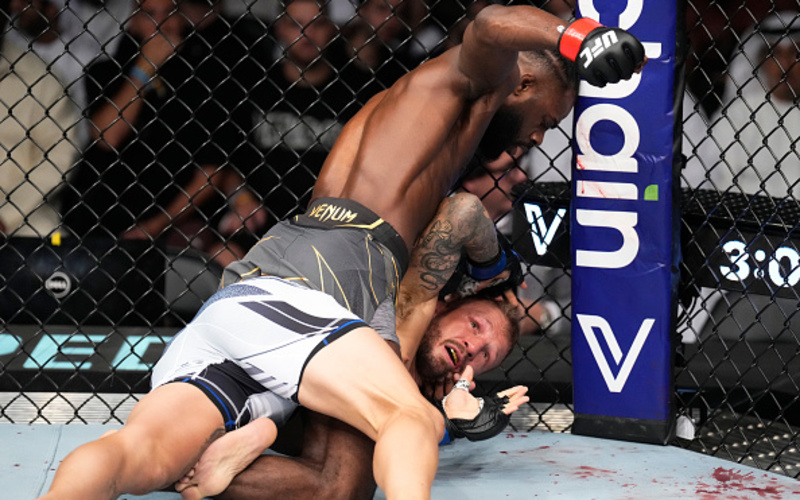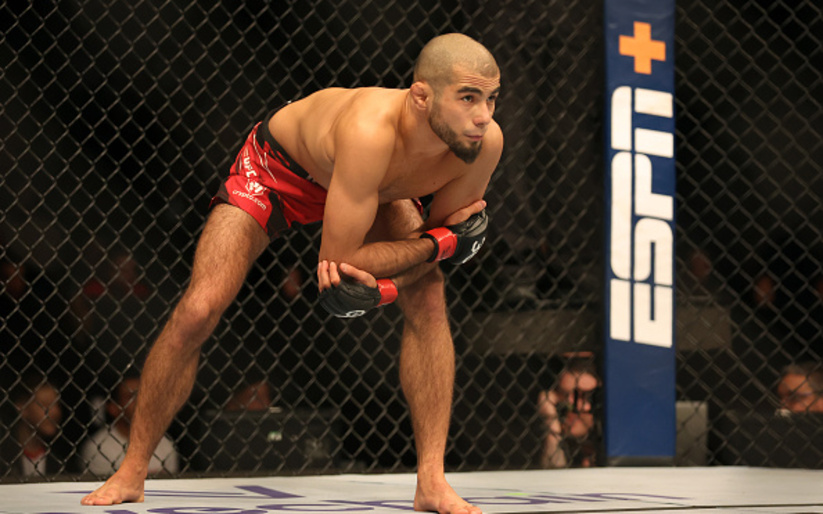On Saturday, former two-time UFC bantamweight champion TJ Dillashaw’s attempt to become a triple time king came to a brutal end. After twenty seconds and a few exchanges, Aljamain Sterling caught a kick and drove through on a takedown. In a critical error, Dillashaw reached out as he fell and his shoulder was dislocated as he crashed down.
But, as it turned out, this was no freak accident. Rather, as he confessed afterwards, Dillashaw’s shoulder had been having issues throughout his camp in the run-up to the fight, having seriously injured it in late April. Subsequently, it had been dislocated on “a good 20” occasions. This no doubt explains Dillashaw’s absence from open workouts and his minimal training footage as the fight approached.
To put it bluntly, this is a story that involves failure. A failure by almost everyone involved to protect the health of one of the bantamweight division’s greatest mixed martial artists. Some of these failures were professional incompetence. Others approach personal betrayals of Dillashaw’s best interests by those who had been working with him for the better part of a decade.
Aljamain Sterling's (@funkmasterMMA) 8-fight win streak is now the longest in UFC bantamweight history.
He is now tied for the most wins in UFC bantamweight history – 13 – with TJ Dillashaw #UFC280
— UFC News (@UFCNews) October 22, 2022
TJ Dillashaw’s Shoulder Injury – How did it come to this?
Firstly, we need to look at the training camp before the fight. Injuries happen in training contact and combat sports. However, the frequency with which Dillashaw’s shoulder dislocated during the camp implies that the rehabilitation necessary for him to continue competing simply did not take place properly. Fighters want to fight. It’s a common error for fighters to have an improper rehabilitation of an injury and worsen it. For instance, after he broke his shin fighting Uriah Hall, Chris Weidman required a second surgery after botching the first rehab. The temptation to train too soon is difficult to resist.
Shoulder dislocations might seem to be no big deal. If you blow out your knee then it’s obvious that there’s no getting around that. With a shoulder, it’s possible to pop it back into place after a dislocation. This is called shoulder reduction. However, care needs to be taken. Just because a reduction has been performed, it doesn’t mean that no damage has occurred. Shoulder dislocations can impact the cartilage around the shoulder, for instance, or the nerves in the arms.
Simply put, when the shoulder kept dislocating, TJ Dillashaw’s camp should have put a stop to his training until the shoulder had time to heal. They have a professional responsibility for their fighter’s welfare. Moreover, Dillashaw’s been working with some of these people for a very long time. He even split from Team Alpha Male to keep working with some of them. They should have shown him similar loyalty. Even if they knew what he wanted was to keep training for what could very well be his last shot at regaining UFC gold, they should have prioritised what he needed most.
Failure of the UFC
As the fight itself approached, the inability of the UFC to pick up on the injury really is a low watermark, even for their trademark cavalier attitude when it comes to fighter safety. It really calls into question why the process even exists. The UFC can’t palm this off onto any commission either, since the whole event took place in Abu Dhabi in the UAE. That means any prefight physical checks would have been entirely the UFC’s responsibility. The very fact that Dillashaw was avoiding open workouts should have attracted extra scrutiny.
Fighters have been lying to commissions about their own health for decades. Legendary heavyweight boxer Smokin’ Joe Frazier became blind in one eye from residual damage from an accident with a speedbag. Frazier employed various strategies to hide this, from colluding with doctors to memorising eye test charts.
The MMASucka podcast crew discussed the failures of the athletic commission in their UFC 280 breakdown podcast.
But Dillashaw was unable to hide his abuse of high-tech PEDs from the UFC. Why should we believe he could hide his badly injured shoulder, except for them not looking hard enough? Perhaps the UFC’s medical assessors should be required to pass their own eye tests.
While appealing to the fighter’s interests has never swayed the UFC before and is unlikely to do so now, the company should still be taking this as a major wake-up call. The UFC is eagerly trying to increase its presence in the gambling industry. It’s even begun several major partnerships such as with DraftKings. It’s a huge disservice to bettors for such important issues to completely elude the company’s perception.
This is all giving the UFC the benefit of the doubt, of course. It’s possible that some officials knew something was up but ignored it to let the show go on.
The Fight
This situation is made even more horrific by the fact that the fight, of course, did not stop when Dillashaw’s shoulder popped out. Normally, UFC referee Marc Goddard could have been forgiven for not immediately noticing that the shoulder was out. However, he had actually been informed about the poor state of the shoulder by Dillashaw before the fight even began. Dillashaw had told him about it in the process of asking for him to let the injury ride if it dislocated mid-fight.
Why Dillashaw thought he could ask for this is certainly questionable. Every fighter wants the TKO to be as late as possible. He might as well have been asking Goddard to let him cheat or asking him to stand up the fight as soon as possible. But what is even more baffling is that Goddard went along with it.
There’s no good reason for this to have happened. While grappling exchanges might have obscured Dillashaw’s injury, once he rose to his feet with about fifty seconds left to go it was obvious. Goddard knew it was out. There’s no possible way a referee of his level of experience couldn’t have known that, even if he hadn’t been told it was a possibility. Even the commentators figured out something was wrong as soon as Dillashaw was first taken down.
TJ Dillashaw’s Shoulder Injury – Technically O.K.
Now, there’s not always a hard and fast rule when it comes to TKOs. Often it comes down to referee discretion. However, broken limbs that are obvious always cause TKOs. It’s too dangerous to let a fighter keep taking hits on a broken limb because of the risk of catastrophic further damage.
A dislocated shoulder is not exactly a broken bone. However, not only is there a risk of something more serious happening, like a torn labrum when a shoulder dislocates, but Dillashaw’s cornermen are not medical professionals.
Any reduction at the end of the round would require them to perform it quickly, meaning mistakes could be made. Recently Aaron Pico’s shoulder dislocated in Bellator and his corner hastily attempted to reduce it back into place. They performed a series of clumsy, sharp movements that looked like they were trying to rip his arm off and which likely only caused further damage. Ultimately the fight was called off and Pico will require surgery.
When Brian Ortega’s shoulder was dislocated by Yair Rodriguez during an armbar attempt, that ended the fight. Dillashaw managing to grit his teeth and bear the pain is impressive but not enough to justify the fight being continued. If it isn’t a written MMA rule that a dislocated limb ends the fight, it absolutely should be.
Goddard letting Dillashaw continue for forty seconds at the end of the first when his shoulder was clearly out and he had only one good arm to protect himself from the reigning bantamweight champion is baffling refereeing at best. Especially coming from a referee who is traditionally known for having good judgement.
The Second Round
Here is where Dillashaw’s camp let him down again. Perhaps they could have fooled themselves into thinking that a shoulder popping out 20 times during camp might have held it together during an intense fight. Alternatively, they might have hoped that Dillashaw would have found a miraculous quick finish.
But now it should have been obvious that victory was out of their reach. You can’t say they hadn’t tried – Dillashaw had fought off back mount from a terrifying control grappler with one working arm. Surely it was time to collect the show money and throw in the towel.
But after absorbing 24 blows to the head – and a few kicks to that arm for good measure – Dillashaw was thrown back in. Of course, the shoulder had been popped back into place, but Dillashaw was clearly extremely wary of throwing the left hand. One of MMA’s most diverse strikers throwing solely right hands, his left arm pinned to his ribs, looked for all the world like a bird with a broken wing trying to take flight.
The shoulder would pop free again after Dillashaw was dragged down by a d’arce choke attempt from Sterling. To his credit, when Dillashaw attempted to reduce it himself Goddard asked him to “show him the left arm” but then seemingly lost interest when Sterling closed again.
Even when Dillashaw was flat on his belly, Sterling on top throwing punches to his head, with one arm dislocated, as helpless as you will ever see a fighter of his calibre in MMA, his corner did not stop the fight. Marc Goddard watched a shoulder pop out twice and stopped the fight only because of unanswered punches.TJ Dillashaw’s Shoulder Injury.
Conclusions
This is unacceptable. Dillashaw had no reasonable chance of winning that fight going into the second round. The referee should have stopped it then. But when Goddard didn’t, neither did Dillashaw’s corner. The result is that in pursuit of an impossible victory, TJ Dillashaw took a total of 56 blows to his head. Make all the dismissals of Aljamain Sterling’s power that you want, CTE is caused by repeated subconcussive blows.
All combat sports are dangerous. MMA is no exception. But there’s a difference between necessary danger and needless danger. Sending out your fighter when their ability to fight is totally compromised is needless. It is not having their back, it is stabbing them in the back. TJ Dillashaw is considered an old hand by MMA standards, but he’s still only 36. He has – hopefully – a good five decades of life expectancy ahead of him.
If this shoulder damage became something far worse – say, because he was rolled around on it while it was dislocated – he would be dealing with those consequences for the rest of his life. This wouldn’t just be in his MMA career, which this fight has doubtlessly shortened, but in any coaching or physical hobbies he chooses to pursue post-career.
TJ Dillashaw is a controversial fighter. But even those who actively dislike him must admit that he has been let down. He was let down by Marc Goddard, who went against his many years of excellent refereeing by not stopping the fight because of his shoulder. He was let down by the UFC, who went along with their many years of not giving a damn about fighters by not properly executing pre-fight checks. And he was let down by his camp of many years, who sent him out defenceless against the #7 ranked P4P fighter in the world.



